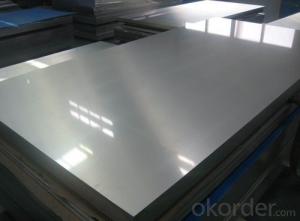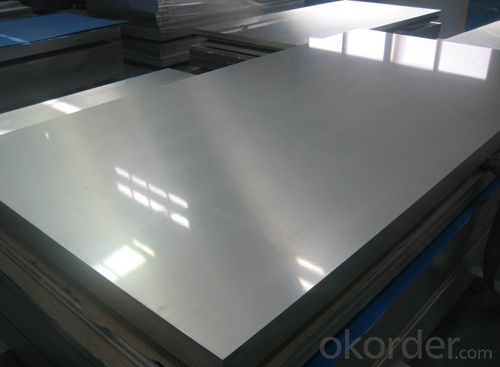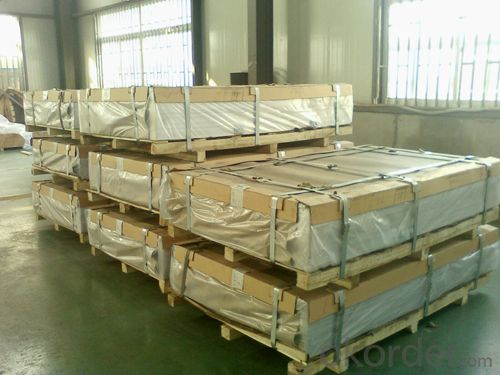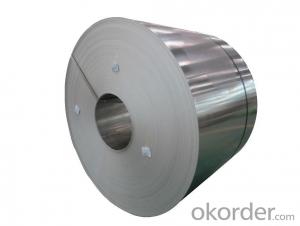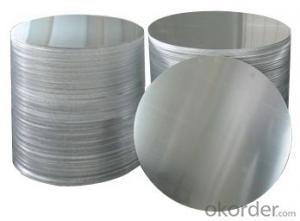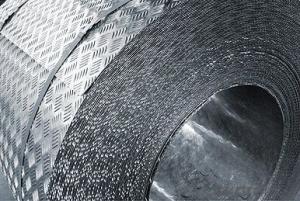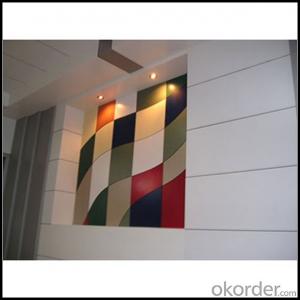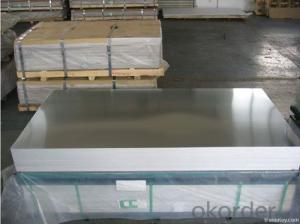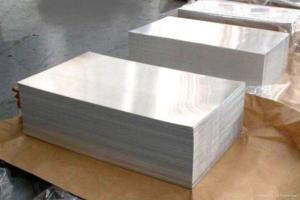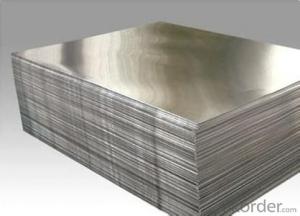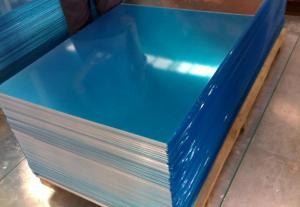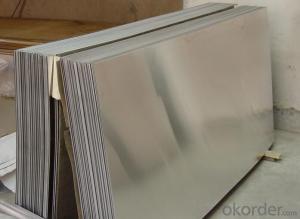7000 Series Alloy Mill Finished Aluminum Sheets in Florida
- Loading Port:
- China main port
- Payment Terms:
- TT OR LC
- Min Order Qty:
- 5 m.t.
- Supply Capability:
- 5000 m.t./month
OKorder Service Pledge
OKorder Financial Service
You Might Also Like
Specification
1.Description of 7000 Series Alloy Mill Finished Aluminum Sheets
| Product | Aluminum sheet |
| Country of Origin | China mainland |
| Alloy | 7075 |
| Temper | T6 |
| Width | 200-1500mm |
| Thinkness | 6-100mm |
| Length | less than 8000mm |
| MOQ | according to different size,normal 5 tons |
| Payment Terms | T/T;L/C |
| Loading Port | DaLian,Tianjing,Shanghai |
| Delivery Time | Within 30 days after receiving the prepayment or original L/C |
2. Technical Parameters of 7000 Series Alloy Mill Finished Aluminum Sheets
alloy | temper | thinkness mm | Tensile strength Rm MPa | The strength of extension Rp0.2 MPa | elongation % |
7075 | 0 | >0.50~1.50 | ≤250 | ≤140 | 10 |
>1.50~4.00 | ≤260 | ≤140 | 10 | ||
>4.00~12.50 | ≤270 | ≤145 | 10 | ||
>12.50~25.00 | ≤275 | — | — | ||
T625 | >0.50~1.00 | 485 | 415 | 7 | |
>1.00~1.50 | 495 | 425 | 8 | ||
>1.50~4.00 | 505 | 435 | 8 | ||
>4.00~6.00 | 515 | 440 | 8 | ||
>6.00~12.50 | 515 | 445 | 9 | ||
>12.50~25.00 | 540 | 470 | — | ||
T6 | >0.50~1.00 | 485 | 415 | 7 | |
>1.00~1.50 | 495 | 425 | 8 | ||
>1.50~4.00 | 505 | 435 | 8 | ||
>4.00~6.00 | 515 | 440 | 8 | ||
>6.00~100.00 | — | — | — |
3. Feature of 7000 Series Alloy Mill Finished Aluminum Sheets
*Such coil is specially designed to replace aluminum ingot, due to the high export tax of aluminum ingot, the coil has better price than ingot.
*This type of coil can fit customer's remelting furnace just like ingot, no need to make any change to the production line that was previously used for ingot. The standard coil size and weight is very suitable for the feed gate of furnace.
*This type of coil causes less material wastage than ingot when remelted.
*Our coil is made directly from ore, no need to go though the ingot making process, quality is much better than other suppliers who use ingot scrap to make coil.
Be free from Oil Stain, Dent, Inclusion, Scratches, Stain, Oxide Dicoloration, Breaks, Corrosion, Roll Marks, Dirt Streaks and other defect which will interfere with use
4. Certificate:
SGS and ROHS(if client request, paid by client), MTC(plant provided), Certificate of Origin(FORM A, FORM E, CO), Bureau Veritas and SGS (if client request, paid by client), CIQS certificate
5. Image of 7000 Series Alloy Mill Finished Aluminum Sheets
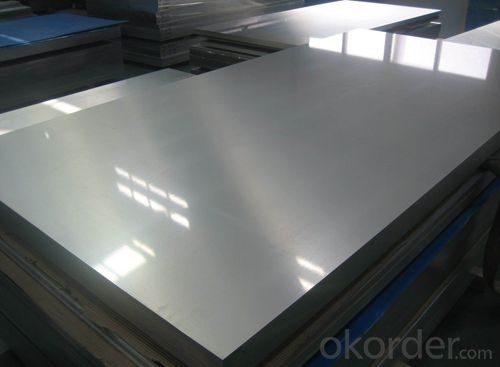
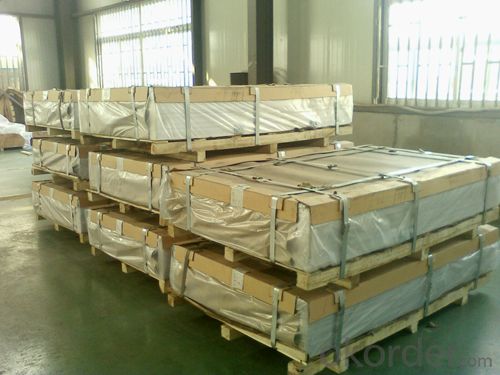
6. FAQ
1) What is your delivery time?
Our regular production time is over 30 days, It depends on the order quantity also.
2) What is your payment term?
We accept T/T, LC at sight, Usance LC 30, 60, 90, 120, 180 DAYS.
3) What is your price structure?
Our foil price is based on Shanghai Metal Price(SMM), not LME, but we could offer LME+ Conversion for your reference.
4) What is your Delivery term?
We do FOB, CFR, CIF, we don't do DDP.
5) Could you offer sample?
We could offer sample as your requirement. A4 Size sample is free for you, for bigger roll sample, it depends on the coil weight.
- Q: Is aluminum a metal or a non-metal?
- Aluminum, a metal, holds the chemical element designation Al along with atomic number 13. Its categorization as a metal stems from its distinctive physical and chemical traits. The characteristics of aluminum include its display of a metallic luster, its ability to conduct heat and electricity, and its possession of considerable tensile strength. Moreover, aluminum is known for its malleability and ductility, enabling it to be effortlessly shaped into various forms. Furthermore, aluminum is typically observed in a solid state when subjected to room temperature, a trait commonly associated with metals. Consequently, aluminum is deemed a metal based on its properties and its placement within the periodic table.
- Q: This is kind of odd, but if a volcano erupted and the lava dripped into an aluminum can, would the can melt? Would the lava harden and cool in it?
- Temperature of lava - 700 degrees Celsius. Melting point of aluminum - 660 degrees Celsius. I'll let you figure out if the can would melt...
- Q: Can aluminum sheets be used in food packaging?
- Indeed, aluminum sheets find widespread application in the realm of food packaging. The utilization of aluminum in this context is prevalent owing to its exceptional capability to shield food from detrimental elements like light, oxygen, moisture, and other external agents that may cause spoilage or contamination. Notably, aluminum sheets possess the qualities of being lightweight, long-lasting, and resistant to corrosion, rendering them perfectly suitable for an array of food packaging formats, including foil wraps, containers, trays, and pouches. Moreover, the recyclability of aluminum further solidifies its status as an eco-friendly option for food packaging.
- Q: What are the different surface treatments available for aluminum sheet?
- There are several different surface treatments available for aluminum sheet, each with its own advantages and purposes. Some of the most common surface treatments for aluminum sheet include anodizing, painting, powder coating, and polishing. Anodizing is an electrochemical process that creates a protective oxide layer on the surface of the aluminum sheet. This treatment not only enhances the corrosion resistance of the metal but also provides an attractive finish. Anodized aluminum can be dyed in various colors, making it a popular choice for architectural and decorative applications. Painting is another popular surface treatment for aluminum sheet. It involves applying a liquid paint coating to the surface, which can provide both protection and aesthetic appeal. Painted aluminum sheets are commonly used in building facades, automotive parts, and other applications where a vibrant and durable finish is desired. Powder coating is a dry finishing process that involves electrostatically applying a powder coating to the aluminum sheet and then curing it under heat. This treatment offers excellent corrosion resistance, durability, and a wide range of color options. Powder-coated aluminum sheets are often used in outdoor furniture, commercial signage, and architectural applications. Polishing is a mechanical surface treatment that involves grinding or buffing the aluminum sheet to create a smooth and shiny finish. This treatment is commonly used for decorative purposes, such as in jewelry, automotive trim, and high-end appliances. It is important to select the appropriate surface treatment for aluminum sheet based on the intended application and desired appearance. Each treatment has its own unique properties and characteristics, so it is always recommended to consult with experts or professionals in the field to determine the best surface treatment for specific requirements.
- Q: Remember the notorious Chevy Vega of the 1970's? As I recall,one the big problems with that car was that it was equipped with an aluminum block engine. The new Ford Mustangs arealso equipped with aluminum engines to reduce curb weightand improve fuel efficiency. Will they be prone to the sameproblems that the Vega had down the road? Are there othermanufacturers that have used aluminum engines with successrecently?
- The problem with the Vega was not so much that it had an aluminum block, as it was an unsleeved aluminum block, i.e. the pistons ran directly on aluminum bores (actually it was an aluminum/silicon alloy that was injection molded, very advanced technology for the time). Although Mercedes had already done this on some of their cars (with mixed success), it didn't work well in the Vega, the bores would scuff and score, and the engine would burn oil badly, sometimes in only 15,000 miles or so. Rebuilt Vega engines had iron sleeves installed and were very sought after. As long as an engine has iron sleeves in the bores there is no reason it shouldn't last as long as an iron engine. There is actually more to worry about with aluminum cylinder heads, they are generally not as durable as iron ones, though they are almost universal now. The fact is, engine technology has come a long way since the 70's, and most modern engines will reach 200k with good maintenance if they are not abused, aluminum or not.
- Q: Can aluminum sheet be used for electrical connectors?
- Yes, aluminum sheet can be used for electrical connectors. Aluminum is a good conductor of electricity and is often used in electrical applications due to its high conductivity, lightweight nature, and cost-effectiveness. However, it is important to consider the specific requirements and conditions of the electrical system to determine if aluminum sheet is suitable for a particular connector application.
- Q: What is the difference between aluminum plate and aluminum-plastic plate?
- Aluminum sheet: aluminum or aluminum alloy (strip) as the base material, processed by molding and surface protection and decorative coating or anodized film of single aluminum sheet (sheet) called aluminum veneer. Aluminum veneer is widely used for architectural decoration called architectural aluminum veneer, the implementation of GB/T23443-2009 standards.Two, aluminum plate: the full name is called aluminum-plastic composite board. The utility model relates to a three layer composite decorative board with plastic as core material, aluminum sheet (sheet) on both sides, and protective coating and decorative coating on the surface of aluminum. There are two kinds of aluminum-plastic panels, one is common decorative aluminum plate, the implementation of GB/T22412-2008; one kind of building curtain wall with aluminum plate, the implementation of GB/T17748-2008.The difference between the three, aluminum single plate and aluminum plate: 1, aluminum veneer is a single plate, only raw materials, namely, aluminum strip and aluminum plate; three layer composite plate, the two sides for aluminum (film) commonly known as aluminum substrate or aluminum substrate, the middle layer is a plastic commonly known as plastic core material, raw materials there are two kinds, one is aluminum plate, two plastic core material; 3, aluminum veneer thickness is generally of no limit, if too thick aluminum plate aluminum base composite is not strong, at present in the world within the scope of the general requirements of aluminum substrate thickness limit of not more than 1mm. The above is the main difference between the aluminum sheet and the aluminum-plastic plate. Upstairs answer, some are wrong, for example, "2", the quality is different: because aluminum plate is less than aluminum plate, aluminum layer, so the aluminum plate than aluminum plate quality must be worse." Please survey.
- Q: What kind of paint should be sprayed on the aluminium board?
- The aluminum need scraping, the car is not easy to enamel paint.Is the aluminum plate with a thickness of more than 0.2mm to 500mm, 200mm width, length less than 16m aluminum material called aluminum plate or aluminum sheet, aluminum is below 0.2mm, 200mm within the width of the row material or bar (of course, with the progress of the large equipment, the width can be 600mm row material also more).
- Q: What are the different methods of surface protection for aluminum sheet?
- There are several different methods of surface protection for aluminum sheet that can be employed to enhance its durability and resistance to various external factors. One common method is anodizing, which involves creating a thick oxide layer on the surface of the aluminum through an electrochemical process. Anodizing provides corrosion resistance, improves wear resistance, and allows for color customization through the use of dyes. Another method is powder coating, where a dry powder is applied to the aluminum surface and then heated to create a durable and protective layer. Powder coating offers excellent resistance to chemicals, UV rays, and scratches, and it also provides a wide range of color options. Laminating is another technique used to protect aluminum sheets. In this method, a thin layer of protective film is applied to the surface, acting as a barrier against scratches, dirt, and moisture. Laminating is commonly used for aluminum sheets that require temporary protection during transportation or storage. Chemical conversion coating is yet another method employed to protect aluminum surfaces. This involves treating the aluminum with a chemical solution that creates a thin layer of protective coating. The coating not only enhances corrosion resistance but also improves paint adhesion. Furthermore, clear coating can be applied to aluminum sheets to provide a protective layer without altering the appearance of the metal. Clear coatings can be either solvent-based or water-based and offer resistance against corrosion, scratches, and UV rays. Lastly, mechanical finishes such as brushing or polishing can be used to protect aluminum surfaces. These finishes create a smooth and aesthetically pleasing surface while also providing some level of protection against corrosion and wear. Overall, these various methods of surface protection for aluminum sheet offer different levels of durability, corrosion resistance, and aesthetic options, depending on the specific requirements and applications.
- Q: Are aluminum sheets suitable for mold making?
- Yes, aluminum sheets are suitable for mold making. Aluminum is a popular choice for creating molds as it is lightweight, durable, and has excellent heat conductivity. These qualities make it ideal for both low-temperature and high-temperature molding processes. Additionally, aluminum can be easily machined or formed into complex shapes, allowing for the creation of intricate molds. It is also resistant to corrosion, which ensures the longevity of the molds. Overall, aluminum sheets are widely used in mold making due to their versatility and reliability.
Send your message to us
7000 Series Alloy Mill Finished Aluminum Sheets in Florida
- Loading Port:
- China main port
- Payment Terms:
- TT OR LC
- Min Order Qty:
- 5 m.t.
- Supply Capability:
- 5000 m.t./month
OKorder Service Pledge
OKorder Financial Service
Similar products
Hot products
Hot Searches
Related keywords
